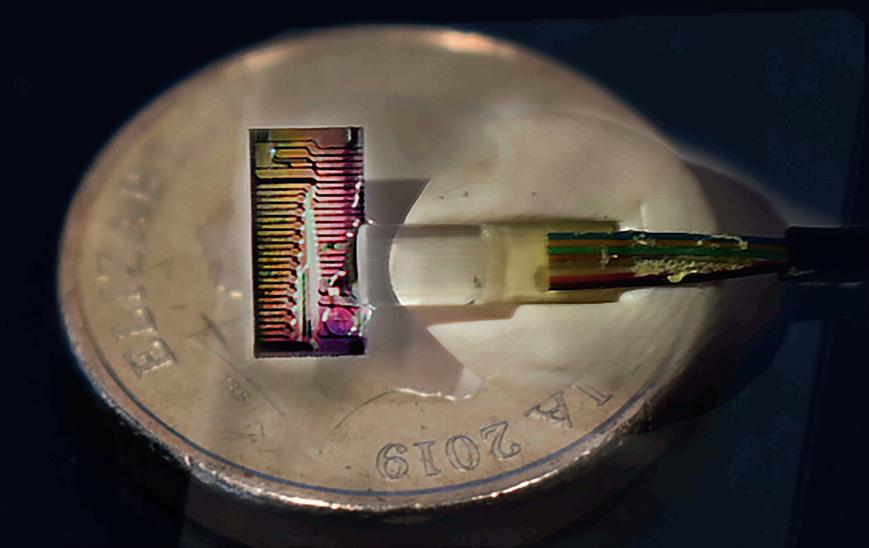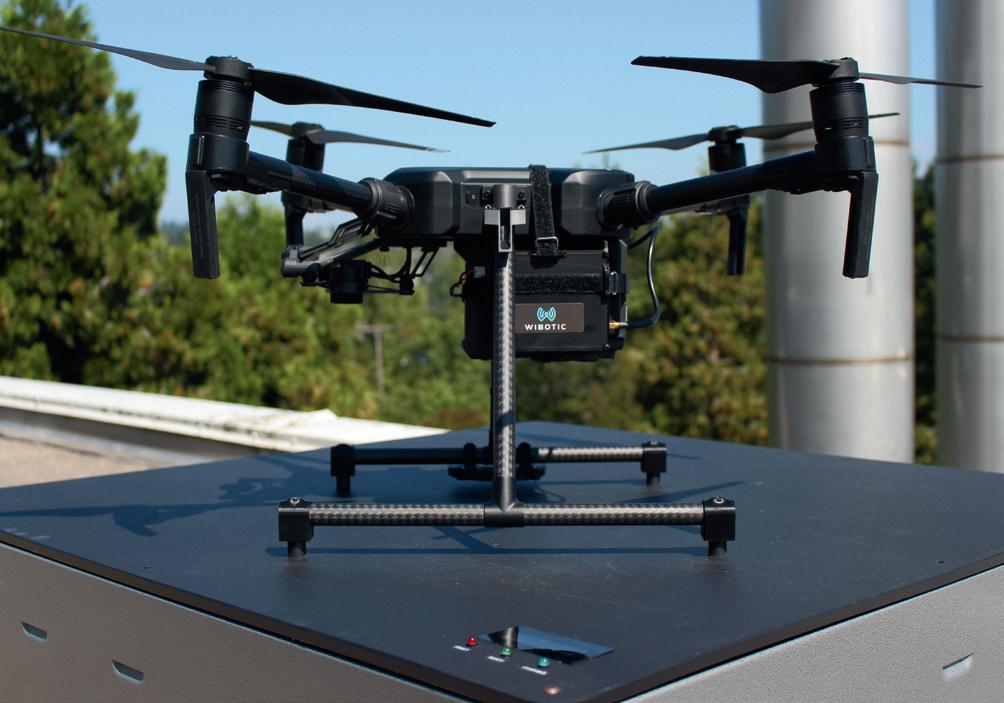
13 minute read
World’s fastest internet speed recorded, researchers claim
Australian researchers have successfully tested and recorded world’s fastest internet data speed from a single optical chip 1000 high-definition movies in a split second.
what is claimed to be the — capable of downloading
The research team from Monash, Swinburne and RMIT universities were able to achieve a data speed of 44.2 Tbps from a single light source. Described in the journal Nature Communications, this technology has the capacity to support the high-speed internet connections of 1.8 million households in Melbourne at the same time, and billions across the world during peak periods.
Demonstrations of this magnitude are usually confined to a laboratory. But for this study, researchers achieved these quick speeds using existing communications infrastructure where they were able to efficiently load-test the network.
They used a new device that replaces 80 lasers with one single piece of equipment known as a micro-comb, which is smaller and lighter than existing telecommunications hardware. It was planted into and load-tested using existing infrastructure, which mirrors that used by the nbn. It is said to be the first time any micro-comb has been used in a field trial and possesses the highest amount of data produced from a single optical chip.
“We’re currently getting a sneak-peak of how the infrastructure for the internet will hold up in two to three years’ time, due to the unprecedented number of people using the internet for remote work, socialising and streaming. It’s really showing us that we need to be able to scale the capacity of our internet connections,” said Dr Bill Corcoran, co-lead author of the study from Monash University.
“What our research demonstrates is the ability for fibres that we already have in the ground, thanks to the nbn project, to be the backbone of communications networks now and in the future. We’ve developed something that is scalable to meet future needs.
“And it’s not just Netflix we’re talking about here — it’s the broader scale of what we use our communication networks for. This data can be used for self-driving cars and future transportation and it can help the medicine, education, finance and e-commerce

RMIT’s Distinguished Professor Arnan Mitchell, co-leader of the research team, said reaching the optimum data speed of 44.2 Tbps showed the potential of existing Australian infrastructure. The future ambition of the project is to scale up the current transmitters from hundreds of gigabytes per second towards tens of terabytes per second without increasing size, weight or cost. “Long term, we hope to create integrated photonic chips that could enable this sort of data rate to be achieved across existing optical fibre links with minimal cost,” Distinguished Professor Mitchell said. “Initially, these would be attractive for ultrahigh-speed communications between data centres. However, we could imagine industries, as well as enable us to read with our grandchildren this technology becoming sufficiently low cost and compact that from kilometres away.” it could be deployed for commercial use by the general public in
To illustrate the impact optical micro-combs have on optimising cities across the world.” communication systems, researchers installed 76.6 km of ‘dark’ Research co-leader Professor David Moss, Director of the Optioptical fibres between RMIT’s Melbourne City Campus and Monash cal Sciences Centre at Swinburne, added, “In the 10 years since University’s Clayton Campus. The optical fibres were provided by I co-invented micro-comb chips, they have become an enormously Australia’s Academic Research Network (AARNet). important field of research.
Within these fibres, researchers placed the micro-comb — con“It is truly exciting to see their capability in ultrahigh-bandwidth tributed by Swinburne University, as part of a broad international fibre-optic telecommunications coming to fruition. This work reprecollaboration — which acts like a rainbow made up of hundreds sents a world record for bandwidth down a single optical fibre from of high-quality infrared lasers from a single chip. Each ‘laser’ has a single chip source, and represents an enormous breakthrough for the capacity to be used as a separate communications channel. part of the network which does the heaviest lifting. Micro-combs Researchers were able to send maximum data down each chanoffer enormous promise for us to meet the world’s insatiable denel, simulating peak internet usage, across 4 THz 180 x 135 mm - australia of bandwidth. mand for bandwidth.”


INTEGRATED SPEED CONTROLLER FOR FLAT MOTORS FAULHABER’s BXT motor family, consisting of brushless DC servomotors with especially short design, has been expanded in all sizes with a diameter-compliant, integrated Speed Controller.
With an additional attachment length of just 6.2 mm, the motor/speed controller combinations are available with the same installation space as the products with the IEF3-4096 (L) integrated encoder. Through the use of synergy effects with the encoder variants, the speed controller is likewise fully integrated in the robust motor housing.
Based on FAULHABER’s SC technology, the motors can be put into operation quickly, easily and comfortably with the familiar Motion Manager (from version 6.6). The speed controller is connected to the application with a six-pole flat cable; suitable connectors are available as an option.
The controller can be combined with the 2214…BXT H, 3216…BXT H and 4221…BXT H housed BXT motors. Even with full integration, the robust device is designed to ensure the use of nearly the entire power and speed range of the corresponding base motors. A well-designed cooling concept minimises thermal losses here.
The combination of the BXT H motors with the integrated speed controller is a suitable solution if speeds need to be controlled precisely in small spaces and high torques are also required. Typical applications are pumps, handheld devices (eg, for the tattoo industry), equipment manufacturing, and laboratory and industrial automation.
Advantages include: compact design through complete integration; high torque up to 92 mNm with continuous output up to 60 W; stable and precise mechanical speed control from 200–10,000 min -1 ; and a second shaft end optionally available in sizes 32 and 42 mm. ERNTEC Pty Ltd www.erntec.net

Accredited testing and global product approvals since 1992
Bayswater

RIBBON FUSION SPLICER The Fitel S123M12 Ribbon Fusion Splicer is a compact, handheld device available for all METRO/ FTTX/ LAN fibres, backbone or long-haul installations. It is available to rent from TechRentals.
Its lightweight, durable metal body frame and rubberprotected corners enable usage in challenging locations, all while maintaining splicer performance. Single- to 12-ribbon fibre splicing can be achieved with this machine and it also offers a splice-on-connector (SOC) solution.
Up to 160 cycles of splicing and heating can be performed using the large-capacity dual-battery configuration, making field use faster and more consistently accessible. Its fixed V-groove allows simple operation while also being compatible with Seikoh Giken and Diamond SOCs. The tool-less electrode replacement/ mirror-free alignment system allows for easy maintenance and software upgrades via the internet. TechRentals www.techrentals.com.au

SMARC 2.1 MODULE Advantech’s ROM-5620 SMARC 2.1 module features an ultralow-power consumption design and extended operating temperature of -40 to 85°C, suitable for automation equipment and HMI devices. It is powered by NXP’s i.MX 8X SoC, with a two- to four-core energyefficient Cortex-A35 processor for mid-range automation and industrial market segments, one Cortex-M4F core for real-time processing and one Tensilica Hi-Fi 4 DSP for efficient audio and voice codec execution.
The ROM-5620 leverages high-bandwidth 2 GB LPDDR4 memory, 16 GB eMMC and dual GbE LAN controllers. It provides a flexible display solution for 1 x dual channel LVDS or 2 x 4-lane MIPI-DSI through software configuration. I/O expansion choices include USB3.0, 2 x USB2.0, PCIe3.0, SDIO and 3 x UARTs for wireless module connectivity. These expansion choices, together with 1 x 4-Lane MIPI-CSI2, 4 x I2C, 2 x SPI, 2 x CAN bus and 12 x GPIO interfaces, cover all essential requirements for automated control and ruggedised application.
The product also comes with Advantech’s WISE-DeviceOn for securely automated device onboarding, remote device monitoring and software over-the-air updates. Advantech Australia Pty Ltd www.advantech.net.au

Signal processing application on Linux.

DIGILENT INTRODUCES FPGA-BASED SIGNAL PROCESSING SYSTEM
As more RF communications, test, software-defined radio (SDR) and other similar applications press the technology further, Digilent, an NI company, has been hard at work to not only keep up the pace but also explore ways to influence the direction of this evolution.
These trending applications employ high-speed analog inputs and/or outputs where real-time signal processing is required, driving the need for higher precision and higher speed solutions. Digilent’s latest Eclypse Z7 Ecosystem is ideal for high-speed instrumentation, control and measurement systems for edge-computing, medical and communications applications. The Eclypse Z7 ecosystem, available from Excelpoint, includes the Eclypse Z7 Xilinx Zynq SoC Platform, Zmod ADC 1410 and Zmod DAC 1411. Zmods products are SYZYGY compliant expansion modules, a high-speed I/O expansion standard for FPGA boards intended to fit between the Pmod standard and FMC. The SYZYGY standard offers a much higher speed/bandwidth digital interface than Pmod but at a much smaller and lowercost form-factor than FMC, enabling the user to configure a FPGA development board with the right I/O for their application.

The Zmod ADC 1410 is equipped with Analog Devices’ AD9648, the dual-channel, high-speed, low-power, 14-bit, 105 MS/s analog-to-digital converter (ADC). Driven by the SYZYGY carrier, the Zmod ADC can acquire two simultaneous signals (1 MΩ, ±25 V, single-ended, 14-bit, 100 MS/s, 70 MHz+ bandwidth). Analog inputs can be connected to a circuit using SMA cables.
The Zmod DAC 1411 is equipped with Analog Devices’ AD9717, the dual-channel, high-speed, low-power, 14-bit, 125 MS/s digital-to-analog converter (DAC). Driven by the SYZYGY carrier, the Zmod DAC can generate two simultaneous signals (50Ω, ±5 V, single-ended, 14-bit, 100 MS/s, 40 MHz+ bandwidth). The analog outputs can be connected to a circuit using SMA cables.
Design the signal processing application on Linux
With the Eclypse Z7 system, engineers and developers can experiment with different signal processing techniques. Digilent provides an example project which showcases the implementation of a Zynq-based 32-order finite impulse response (FIR) filter design on Linux. The 32-order FIR filter, clock-enabled generator and a signal generator are implemented in the programmable logic of the Xilinx Zynq 7000 SoC. A Linux OS is run on the processing system. Quantification of the coefficients, a Hanning window, can be computed in C. The details are available at the Digilent Project Page.
Wireless charging enabled for robot fleets
As robotic fleets reshape logistic, delivery and inspection industries, the demand for more efficient and flexible charging solutions is increasing while the feasibility for these fleets to be managed manually and recharged ad hoc by a 24/7 rotation of personnel is decreasing. The next step is towards enhanced autonomy, whereby normal operations can be sustained without human intervention. This is where WiBotic comes in.
WiBotic provides wireless charging and power optimisation solutions that are integral to charging the rapidly growing ecosystem of aerial, mobile, marine and industrial robots. A range of solutions enable robots and unmanned vehicles (UVs) to be recharged through wireless charging stations, eliminating the need for human operators to physically connect the robots to chargers. In addition, wireless charging technology reduces wear and tear on physical connection points, trip hazards from power cords and floor-mounted charging stations, and the space requirement for dedicated charging rooms.
WiBotic wireless charging solutions are designed to facilitate many-to-many operation, whereby multiple robots (including from different manufacturers) can charge from the same transmitter at different times. Alternatively, an entire fleet of robots can move between a network of transmitters in different locations within a warehouse. In short, any robot can charge from any station, even if the robots have different battery chemistries, voltages and charging current. Such wireless charging innovation has been made possible with the Vicor 48 V VI Chip PRM Regulator — a 400 W high-efficiency converter that operates from a 36–75 V input to generate a regulated output. The device powers the adaptive matching transmitter onboard the WiBotic TR110 wireless charging station, which feeds power wirelessly to the robot’s or UV’s onboard receiver. The PRM accepts 48 V from an AC/DC power supply and the output voltage is adaptively controlled and trimmed from approximately 20–55 V. The Vicor PRM enables consistent, highefficiency conversion across the full range of impedances, flexibly supporting ‘full charge’ and ‘trickle charge’ modes with no significant drop-off in efficiency at lower power levels — a critical performance benchmark that competing power components failed to achieve, the company claims. This high-efficiency conversion capability yields a tightly consistent, maximum device temperature of 40–45°C, helping to neutralise thermal management constraints across the full power range.
WiBotic delivers a dynamic charging solution that is designed to enable the next generation of autonomy, freeing robotic devices from the confines of manually managed charging processes and helping them achieve new levels of functionality and productivity — with no power constraints to hold them back.


Vicor Corporation www.vicorpower.com
FULLY RUGGED LAPTOP Getac has revealed its B360 fully rugged laptop, engineered for 5G and featuring good computing speed and brightness. This results in a mobile solution that is designed to excel in challenging working conditions in industries such as public safety, manufacturing, utilities and defence.
The product runs on the 10th Generation Intel Core Processor, making it capable of running large numbers of applications simultaneously without any impact on performance, and the display is 1400 nits Full HD. An IP66 rating means it is completely protected from dust ingress, as well as high-pressure water jets and spillages. The device can also withstand drops of up to 1.8 m when in operation, while the latest MIL-STD 810H certification gives users confidence in its ruggedness.
At just 34.9 mm thick and weighing 2.32 kg, the B360 can be carried and operated for extensive periods of time without causing user fatigue. Despite such a compact form factor, it features an expansive 13.3″ LumiBond 2.0 display for usability in all situations and weather conditions. The latest 802.11ax Wi-Fi delivers wireless speeds up to three times faster than previous generations. Dual hot-swappable batteries ensure full-shift functionality between charges, while optional GPS makes mapping, surveying and tracking in the field quick and easy. An optional barcode reader also makes intelligence gathering at the scene of an incident fast and convenient.
The B360 Pro, optimised for the defence sector, includes all the core technology specifications of the B360 along with a number of additional features and build options that are vital for military personnel. High-capacity hot-swappable batteries deliver even more operating time between charges, while additional serial ports allow legacy and/or customised military equipment to be connected directly to the device. Users also have the option to spec a PCMCIA, ExpressCard or a discrete graphics card, as well as a DVD or Blu-ray drive as required. Getac Technology Corp www.getac.com/apac/


FRAME GRABBER Matrox Imaging has announced the Matrox Rapixo CL Pro frame grabber, with support for highperformance Camera Link cameras. Each Pro board delivers onboard image processing offload to FPGA devices, high frame-rate image capture, support for extended cable lengths and good image acquisition.
The product makes use of an FPGA device from the Xilinx Kintex-7 family, directly integrating control, format and stream logic onto the frame grabber itself. Paired with the Matrox FDK, a powerful development kit, the Pro models support development of custom FPGA configurations to relieve the host system of intensive image-processing functions.
An enhanced iteration of the Matrox Radient eV series of Camera Link boards, the frame grabber capably handles image capture from an extensive range of devices, from a single low data-rate Camera Link device to multiple maximum-bandwidth Camera Link cameras. Users can interface with up to four Base or two Full/80-bit mode Camera Link cameras at up to 85 MHz on a single board. With integrated Power-over-Camera Link (PoCL) and extended cable lengths support, the Pro boards are designed to simplify cabling requirements. Dindima Group Pty Ltd www.dindima.com








